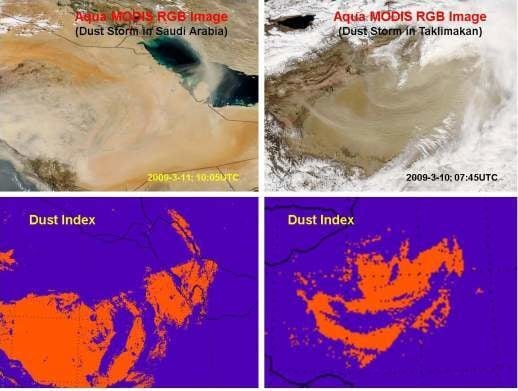Dust and Smoke Detection for Multi-Channel Imagers
Abstract
:1. Introduction
2. Dust Detection Algorithm
- BT—brightness temperature (wavelength is given in subscript, e.g., BT11μm)
- R—reflectance (wavelength is given in subscript, e.g., R0.64µm)
- BTD—brightness temperature difference
- MeanR—mean of reflectance for 3 x 3 pixels (wavelength is given in subscript, e.g., MeanR0.86µm)
- StdR—standard deviation of reflectance for 3 x 3 pixels (wavelength is given in subscript, e.g., StdR0.86µm)
- Rat1 = (R0.64µm − R0.47µm)/(R0.64µm + R0.47µm)
- Rat2 = (Rat1 × Rat1)/(R0.47µm × R0.47µm)
- R1 = R0.47µm/R0.64µm
- R2 = R0.86µm/R0.64µm
- NDVI = (R0.86µm − R0.64µm)/(R0.86µm + R0.64µm)
- MNDVI = NDVI2/(R0.64µm × R0.64µm).
2.1. Dust Detection over Land
- (1)
- Good data test for BT and R:
- •
- R0.47µm, R0.64µm, R0.86µm, R1.38µm > 0
- •
- BT3.9µm, BT11µm, BT12µm > 0K
- (2)
- BTD and R tests:
- •
- BT11µm − BT12µm ≤ −0.5K & BT3.9µm − BT11µm ≥ 20K & R1.38µm < 0.055(screen for pixels that are water cloud free. If these conditions are not met, then the pixels are cloudy and terminate testing)
- (3)
- Dust test:
- •
- If BT3.9µm − BT11µm ≥ 25K then dust
- •
- If MNDVI < 0.08 & Rat2 > 0.005 then dust
- (4)
- Thick dust test:
- •
- BT11µm − BT12µm ≤ −0.5K & BT3.9µm − BT11µm ≥ 25K & R1.38µm < 0.035
- •
- MNDVI < 0.2

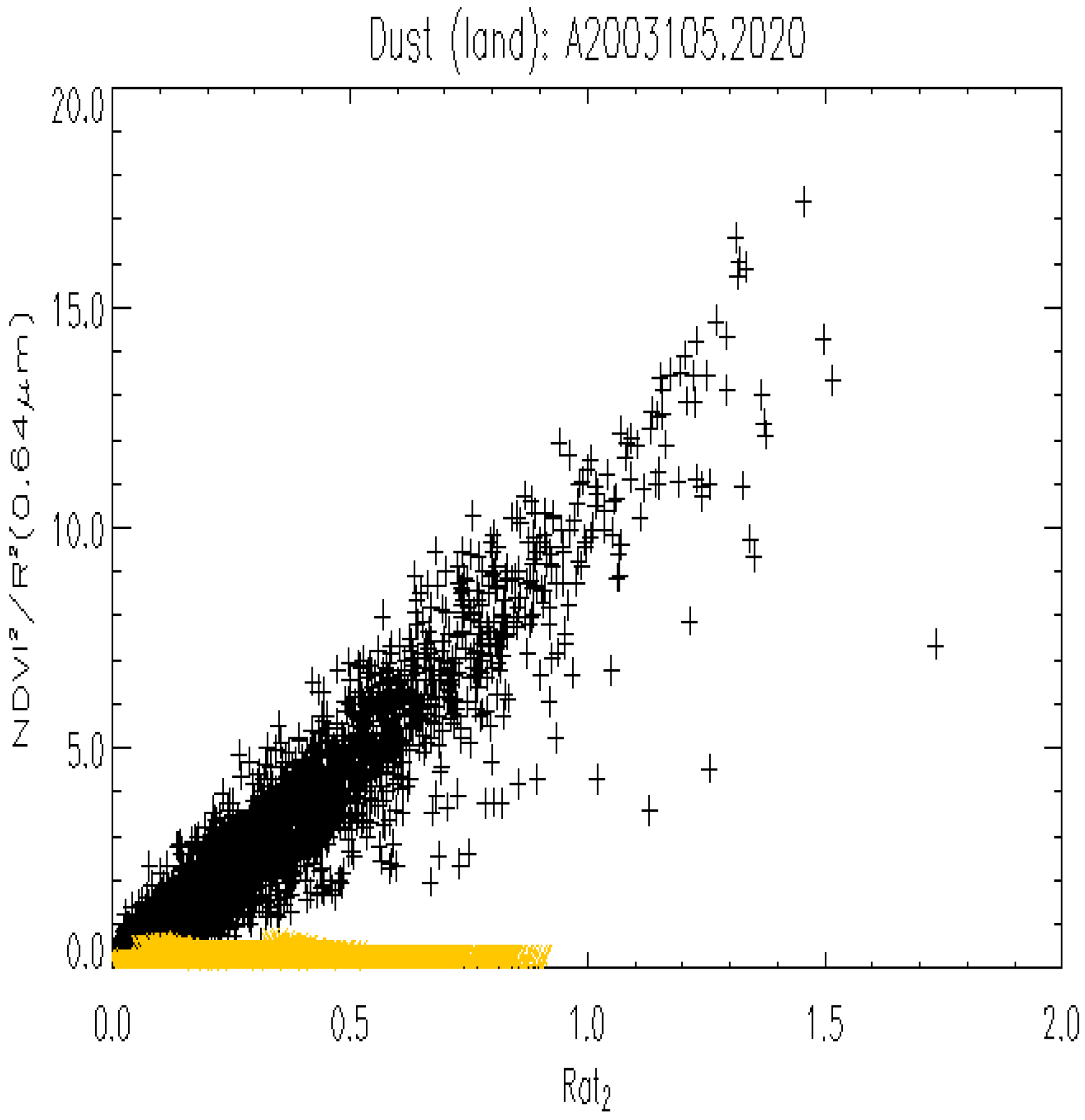
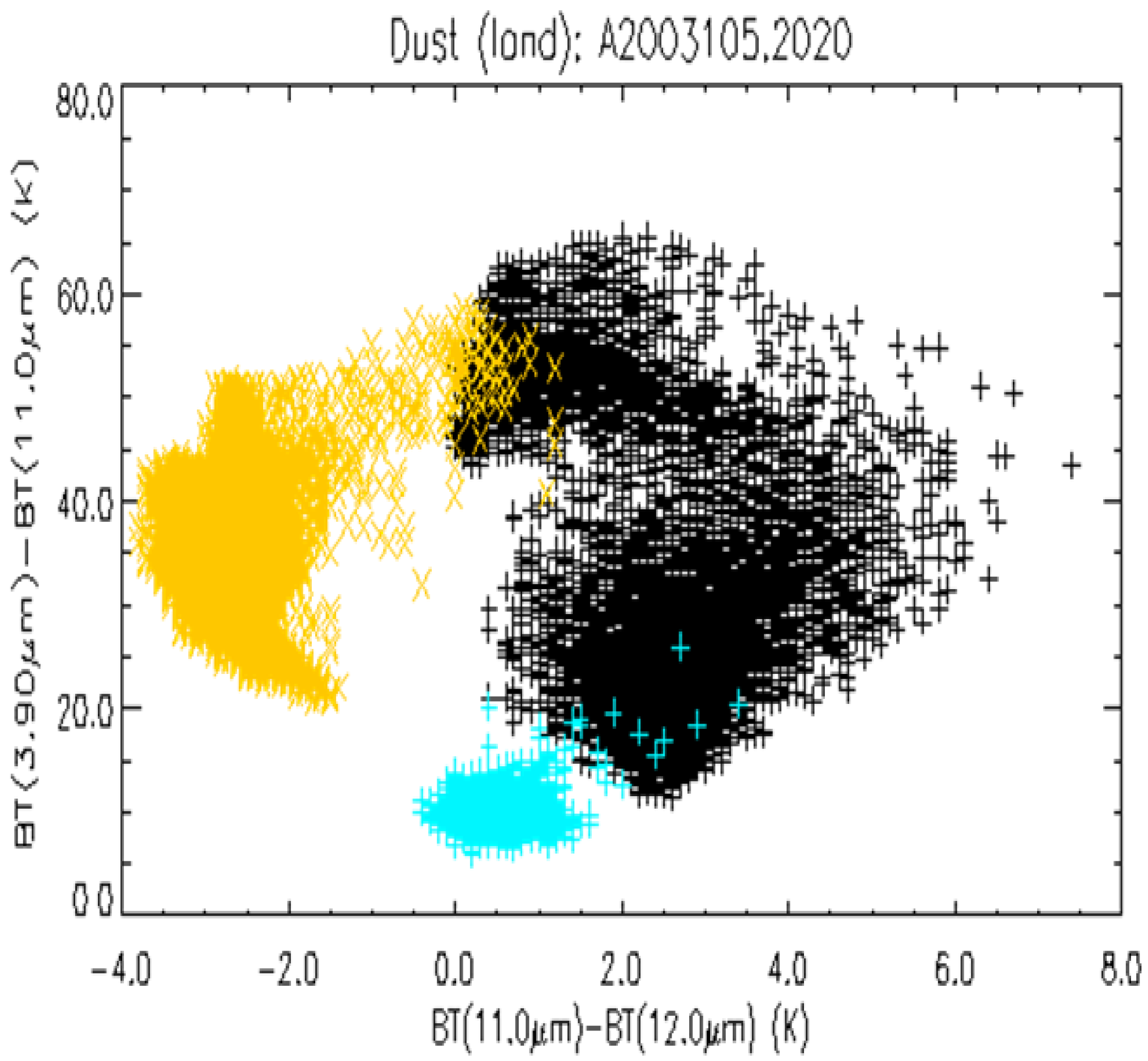
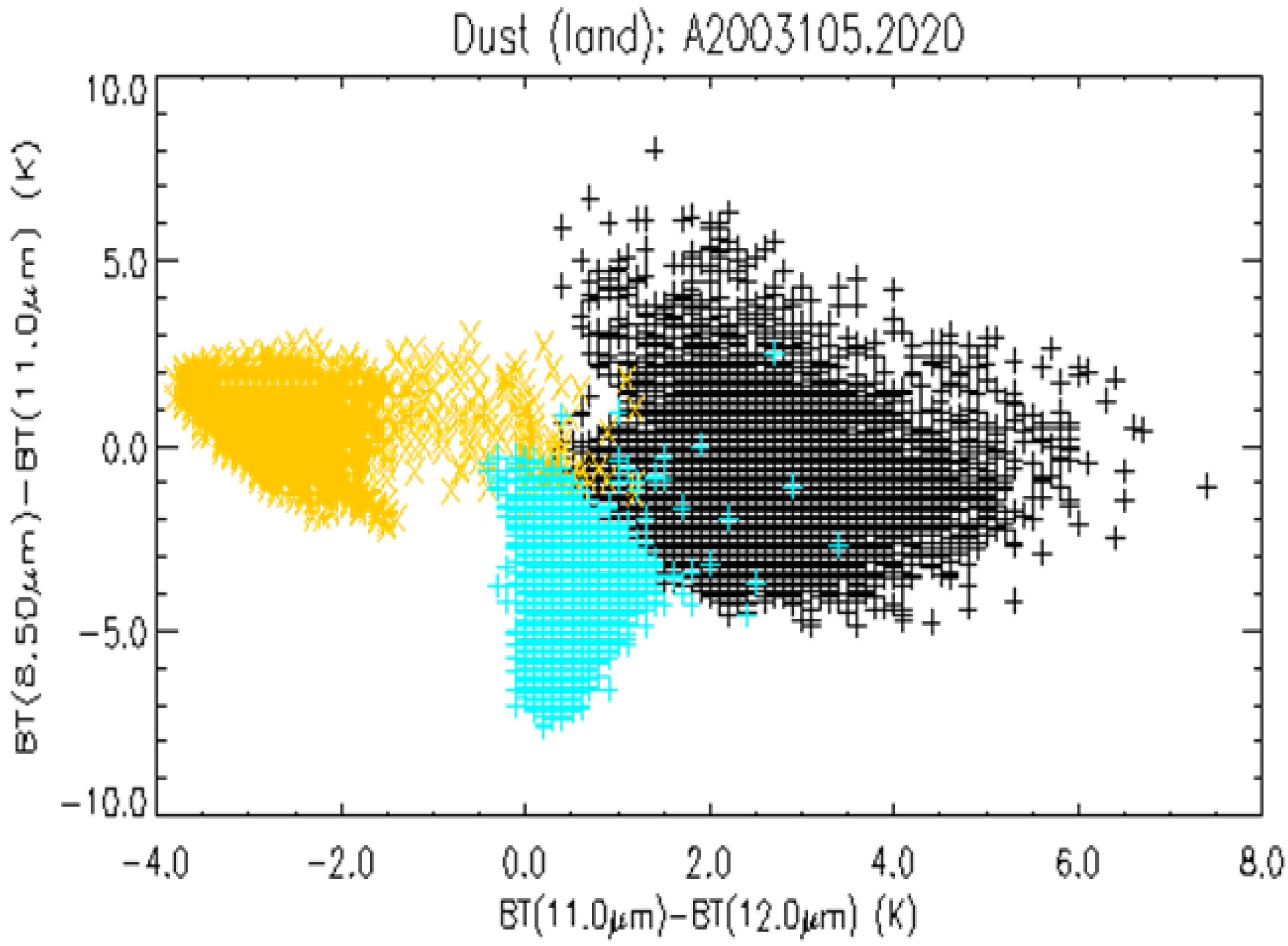
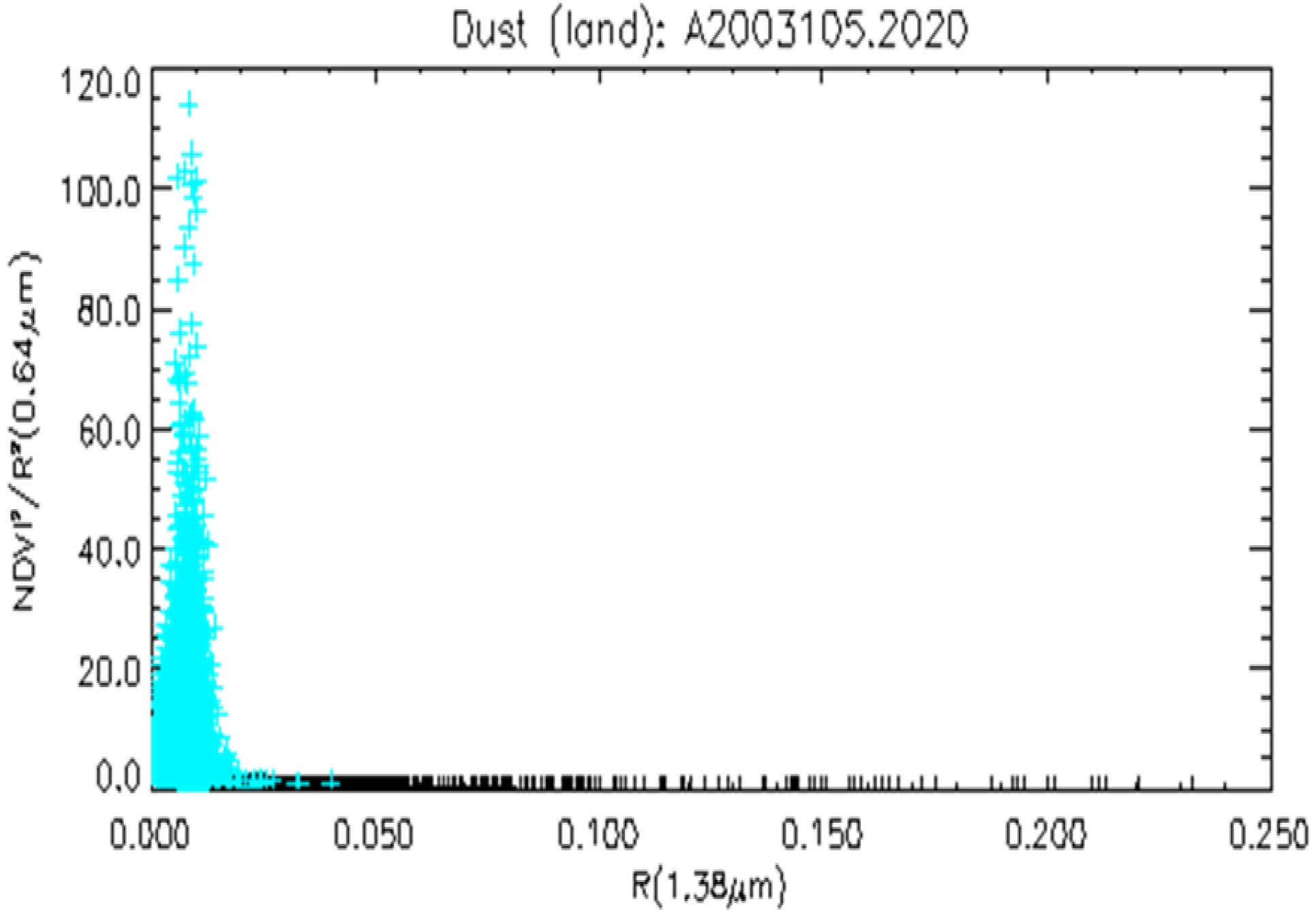
2.2. Dust Detection over Ocean
- (1)
- Good data test:
- •
- R0.47µm, R0.64µm, R0.86µm > 0
- •
- BT3.9µm, BT11µm, BT12µm > 0K
- (2)
- BTD and R tests plus uniformity texture tests:
- •
- 4K < BT3.9µm − BT11µm ≤ 20K
- •
- R0.47µm ≤ 0.3
- •
- MeanR0.86µm > 0 and StdR0.86µm ≤ 0.005 (3 × 3 pixels)(identify water cloud)
- (3)
- Dust test:
- •
- if BT11µm − BT12µm < 0.1K and -0.3 ≤ NDVI ≤ 0 then dust
- •
- if R0.47μm/R0.64μm < 1.2 then dust
- •
- if BT3.9µm − BT11µm > 10K & BT11µm − BT12µm < −0.1K then dust
- (4)
- Thick dust test:
- •
- BT3.9µm − BT11µm > 20K (define potential thick dust regime)
- •
- if BT11µm − BT12µm ≤ 0K and −0.3 ≤ NDVI ≤ 0.05 then heavy dust
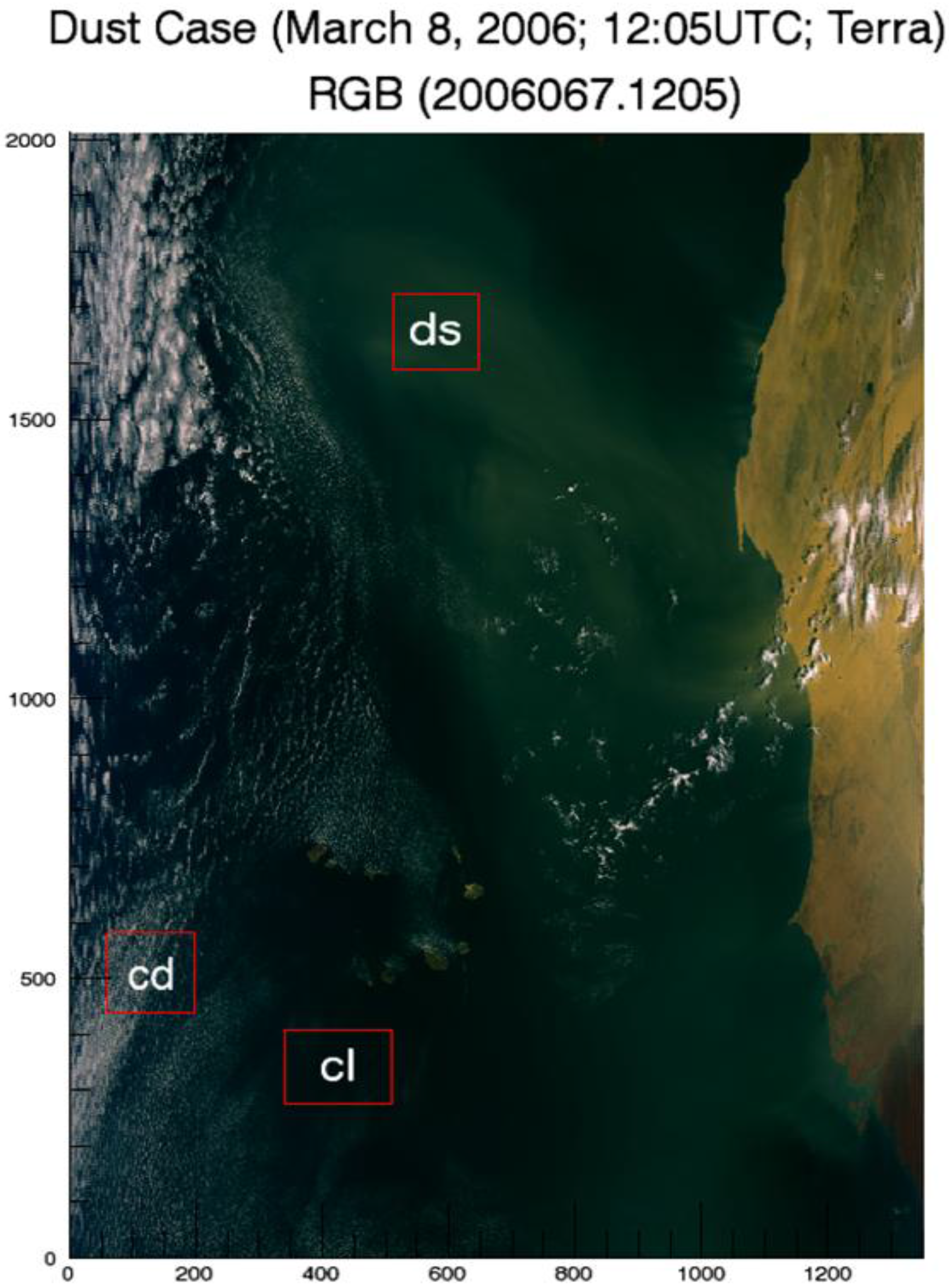
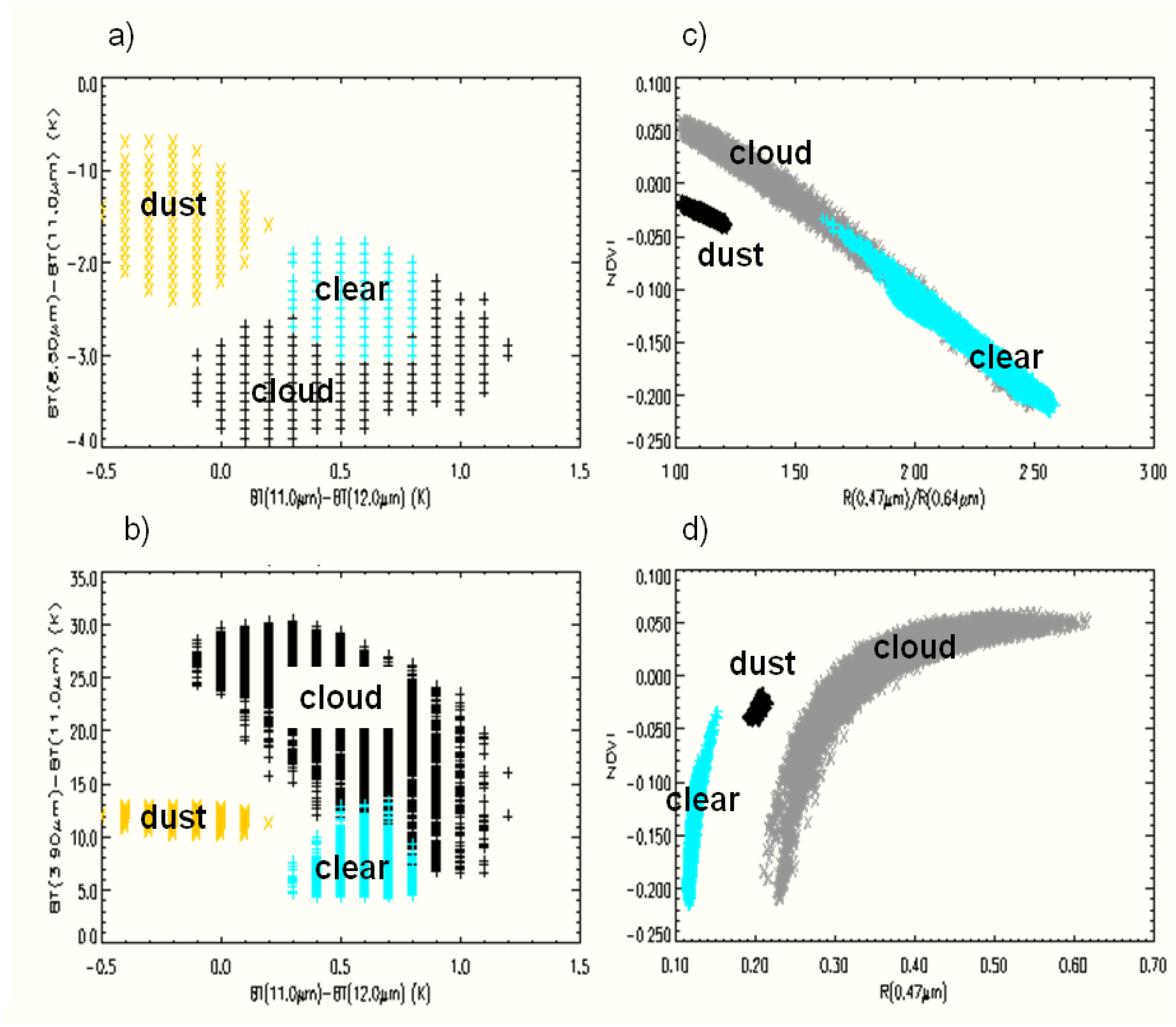
3. Smoke Detection Algorithm
3.1. Smoke Detection over Land
- (1)
- Good data test:
- •
- R0.47µm, R0.64µm, R0.86µm, R2.26µm > 0
- •
- BT3.9µm, BT11µm > 0K
- (2)
- Fire detection:
- •
- BT3.9µm > 350K and BT3.9µm − BT11µm ≥ 10K
- (3)
- Spectral and uniformity tests:
- •
- R2.26µm < 0.2
- •
- R0.64µm > (−0.006 + 0.611R2.26µm)
- •
- R1 ≥ 0.85 and R2 ≥ 1.0
- •
- if StdR0.64µm ≤ 0.04 (3x3 pixels) then thick smoke
- (4)
- If fire or thick smoke then smoke.
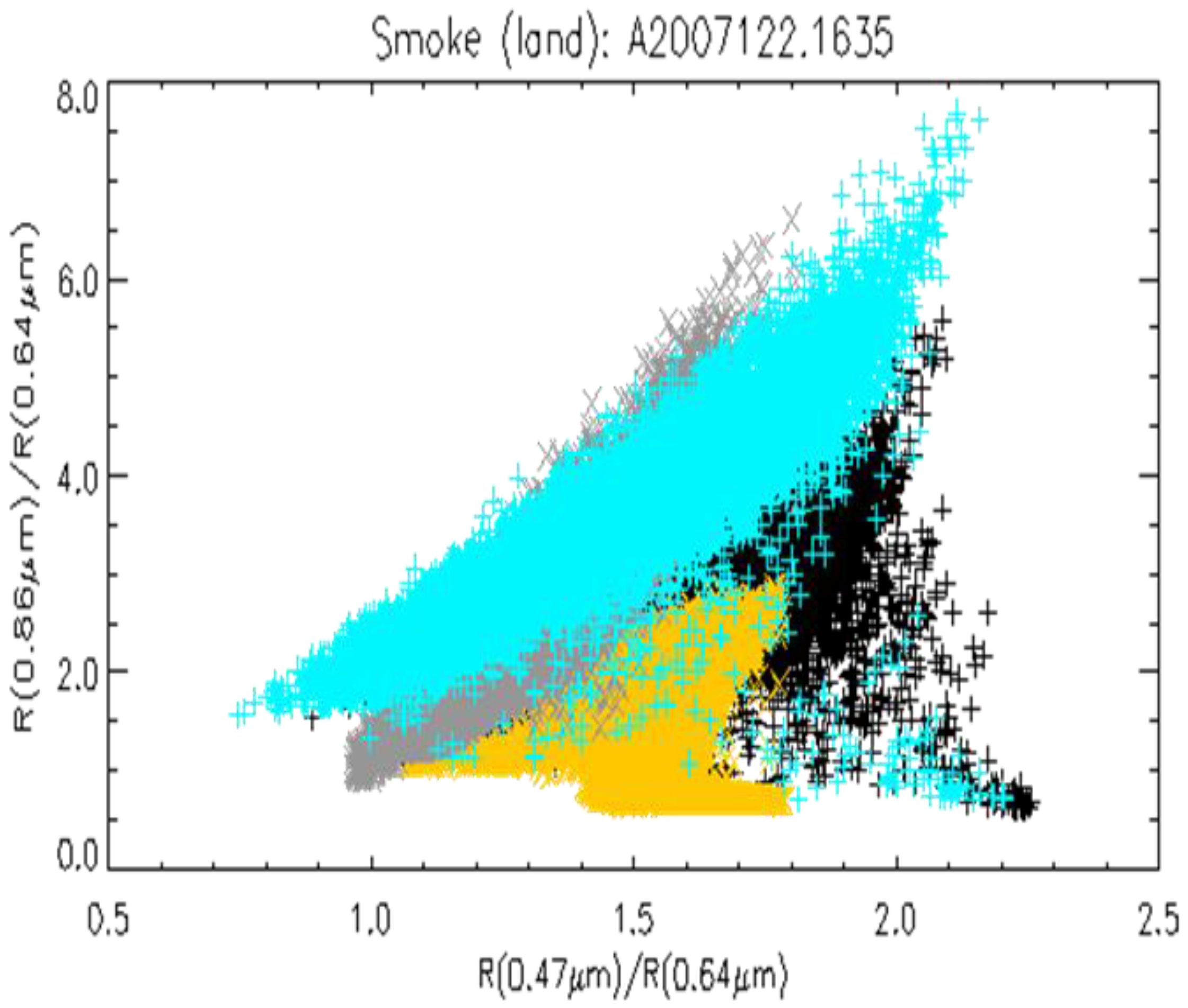
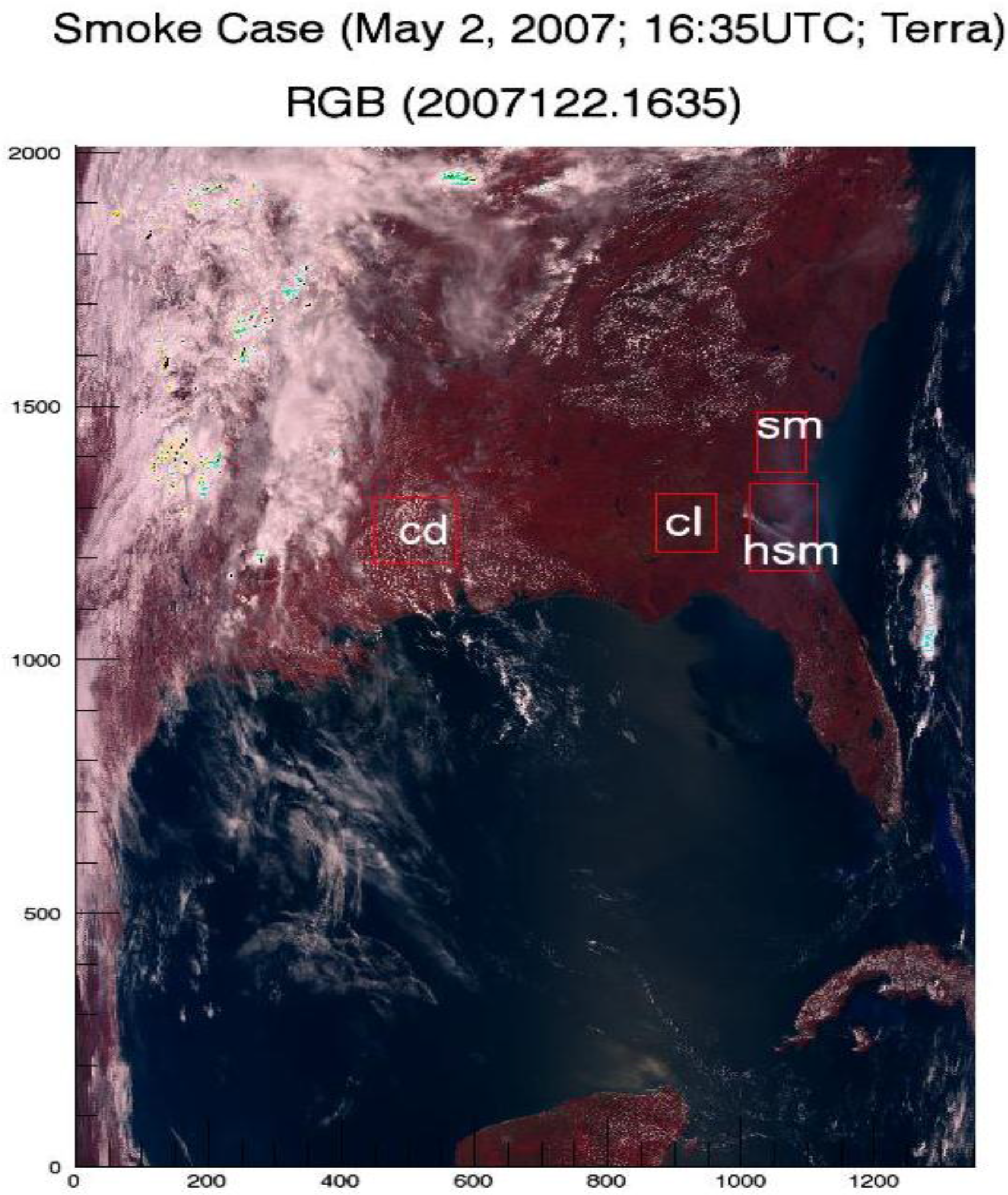
3.2. Smoke Detection over Ocean
- (1)
- Good data test:
- •
- R0.47µm, R0.64µm, R0.86µm > 0
- •
- BT11µm > 0K
- (2)
- Reflectance test:
- •
- 0.2 < R0.47µm < 0.25 and 0.05 < R0.86µm < 0.15
- (3)
- Brightness temperature and uniformity test:
- •
- BT11µm > 290K
- •
- StdR0.86µm ≤ 0.005 (3 × 3 pixels)
- (4)
- Reflectance ratio test:
- •
- 1.5 < R1 < 2.0 and 0.6 < R2 < 1.0
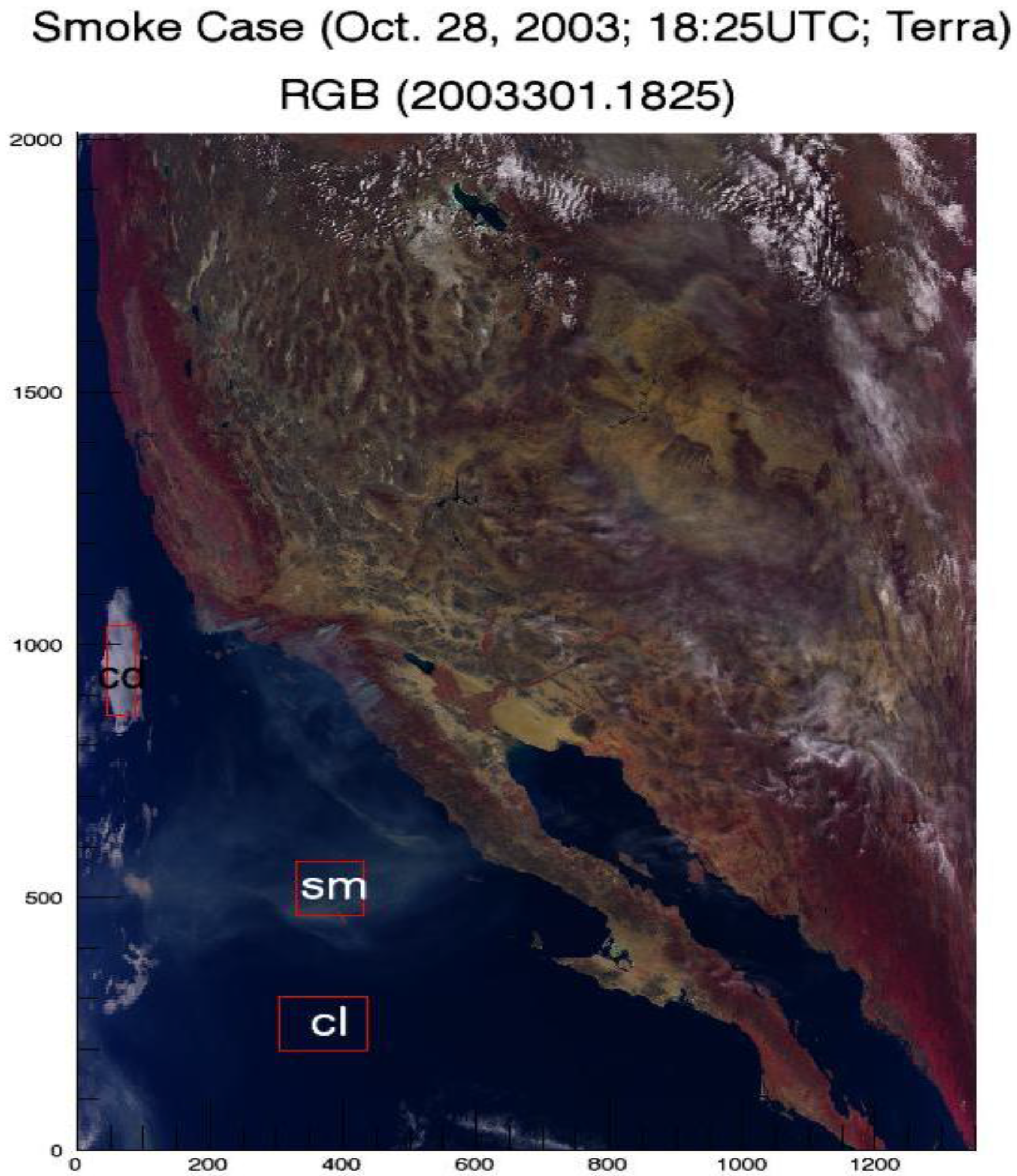
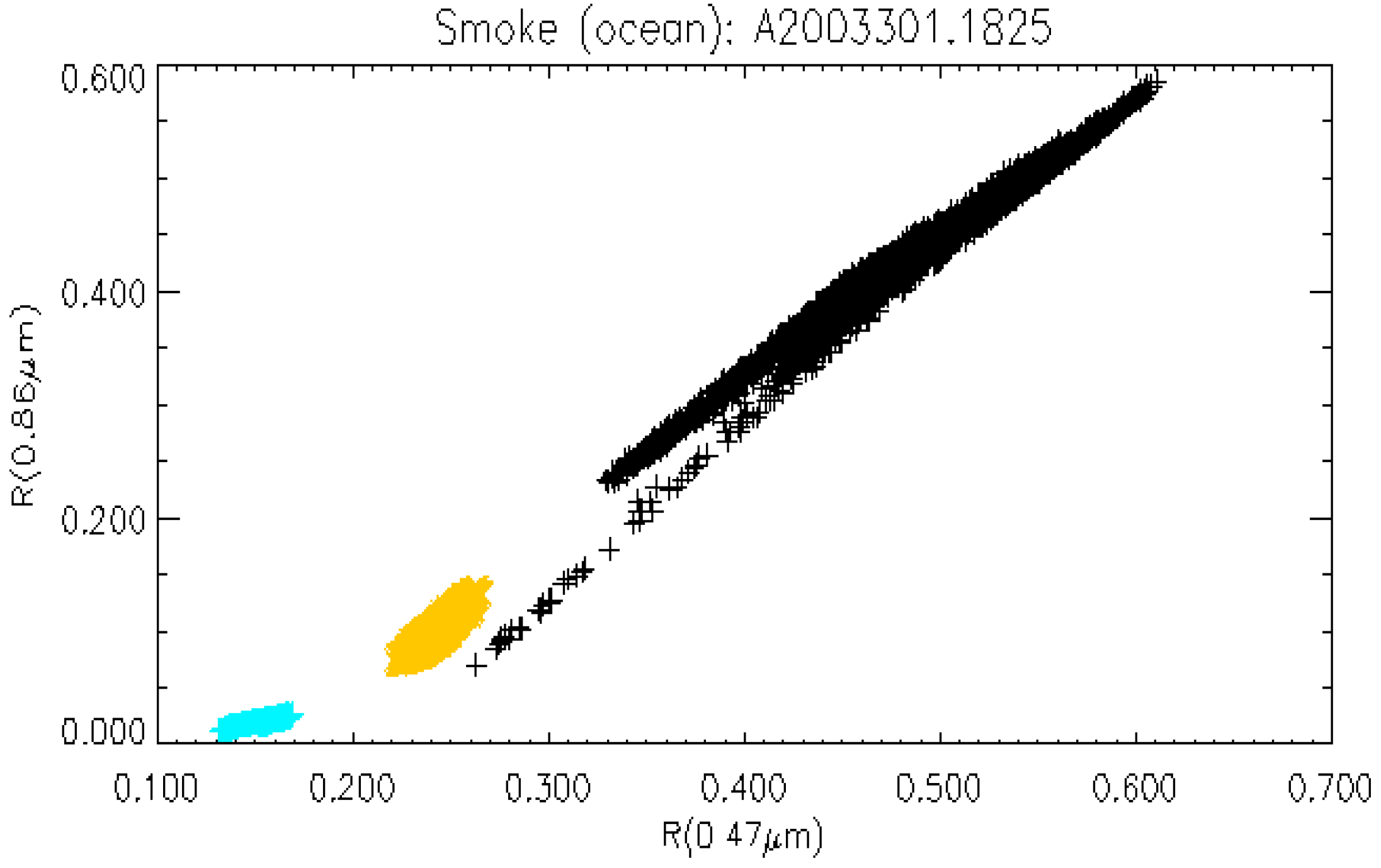
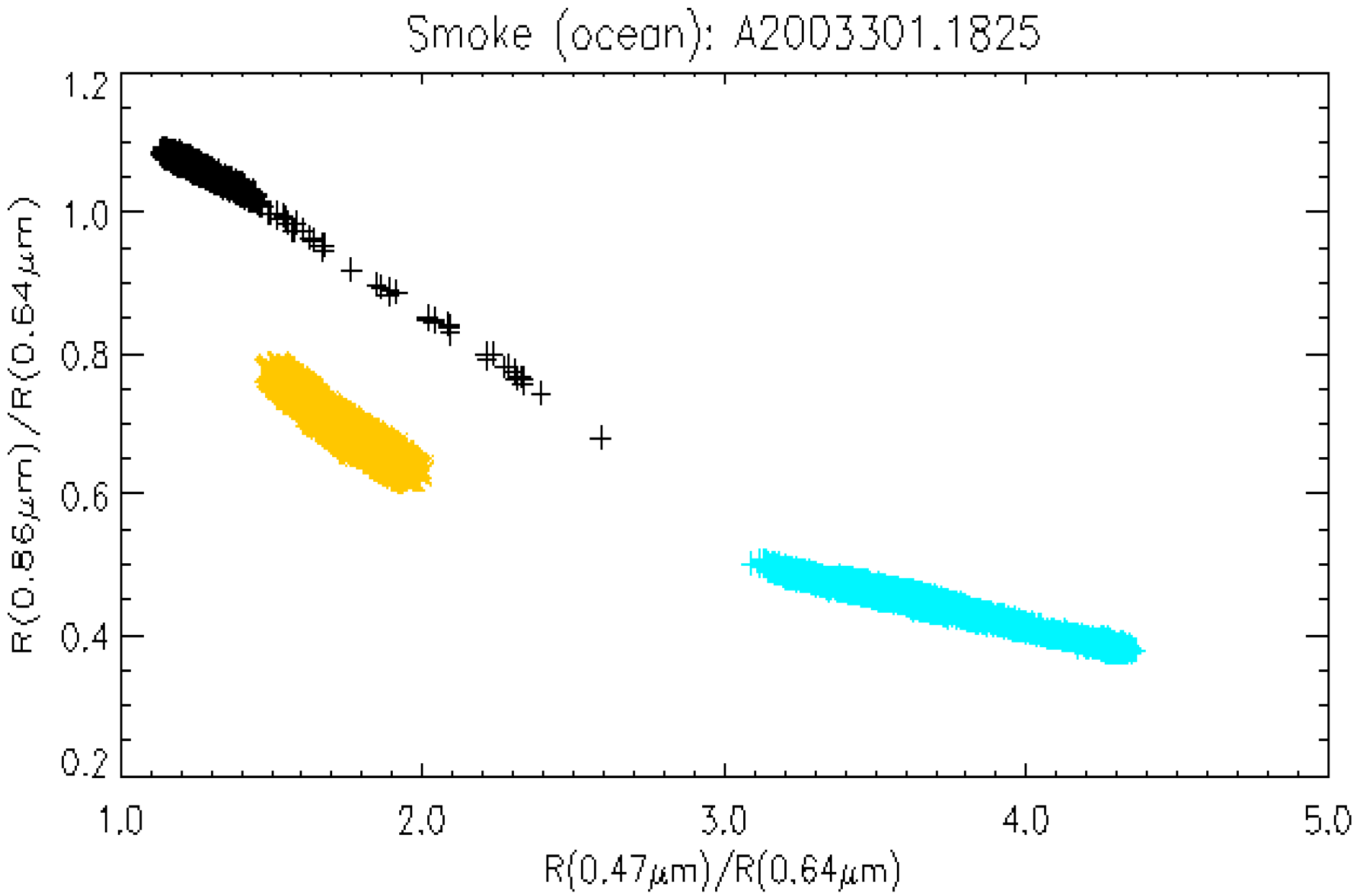
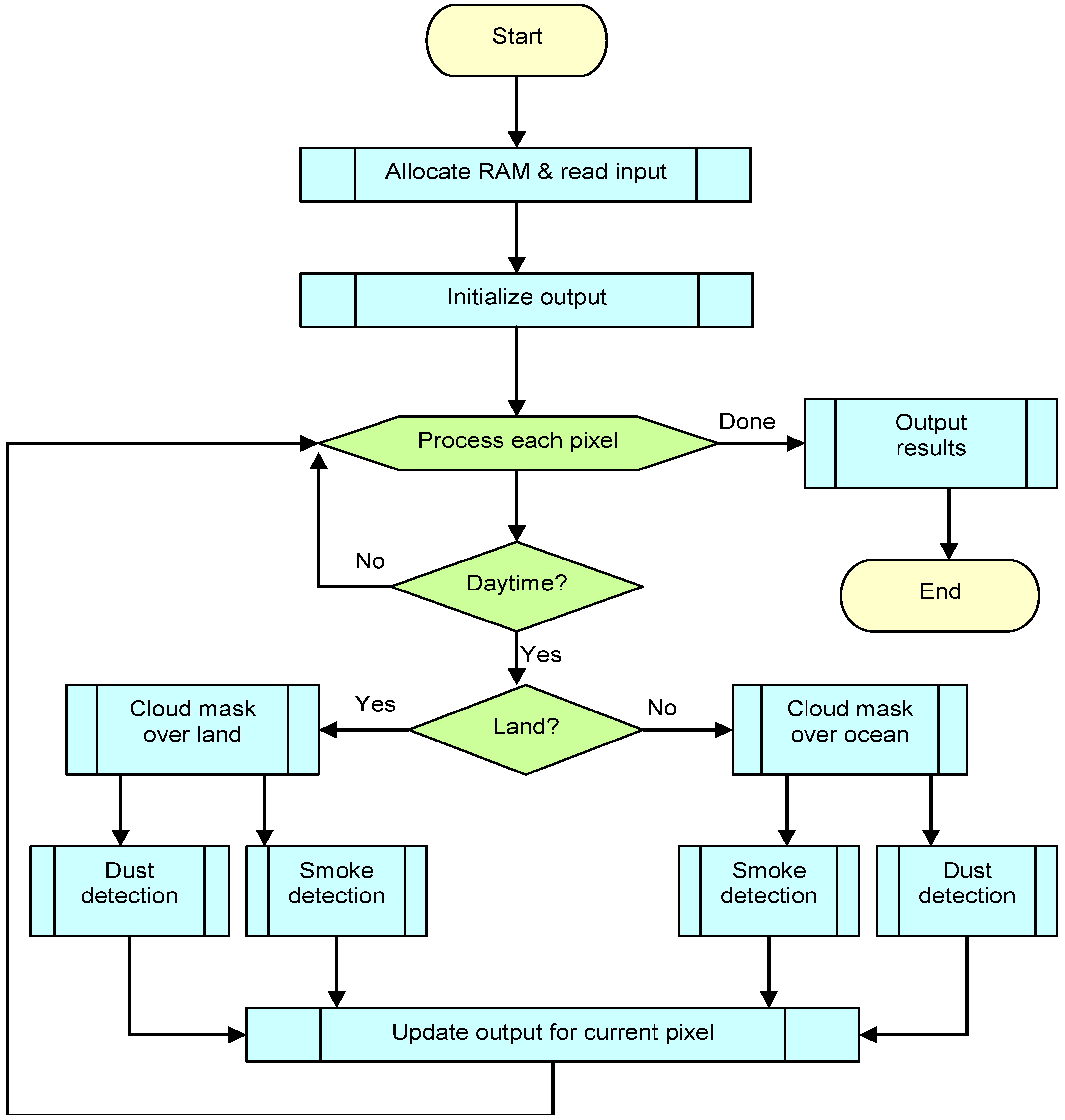
4. Detection Results and Validation
4.1. Dust over Land

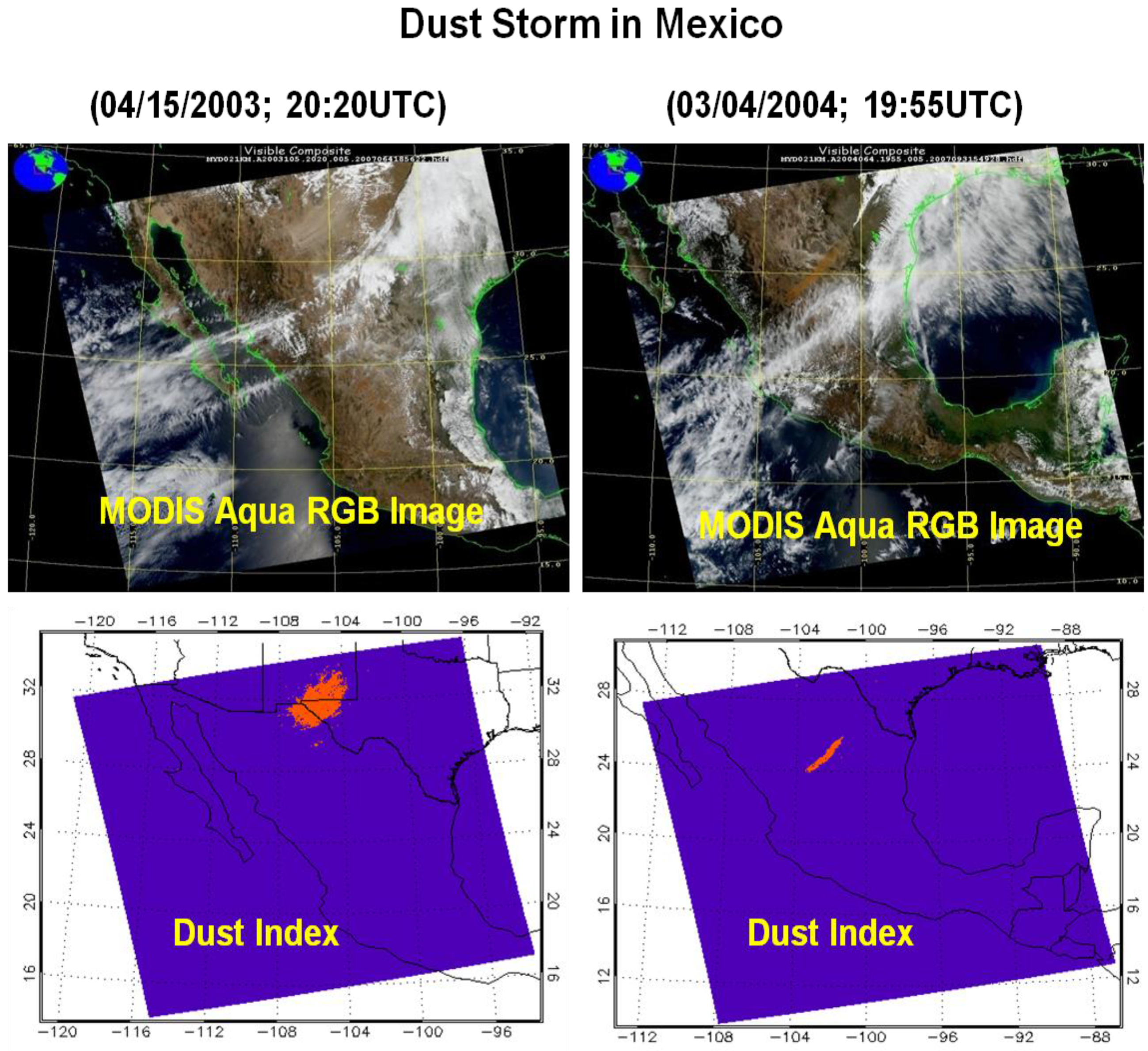
4.2. Dust over Ocean
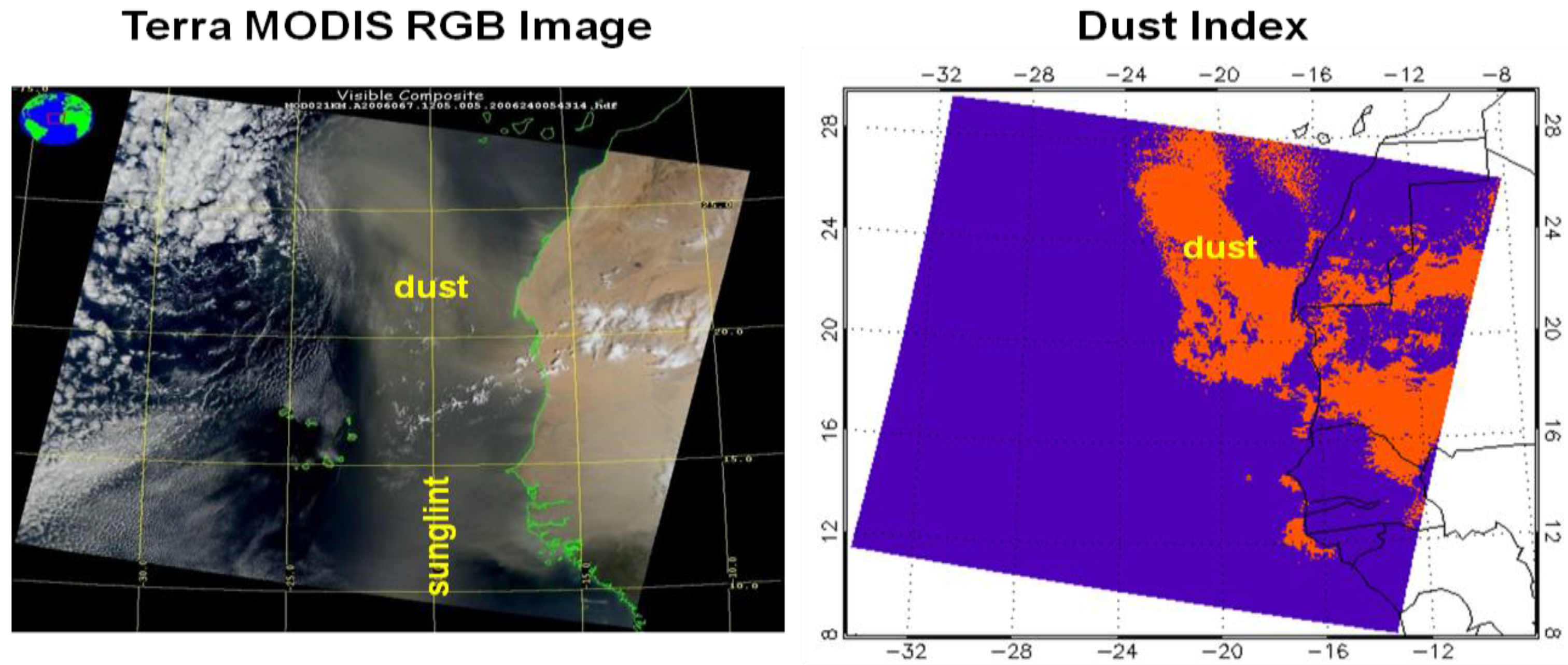
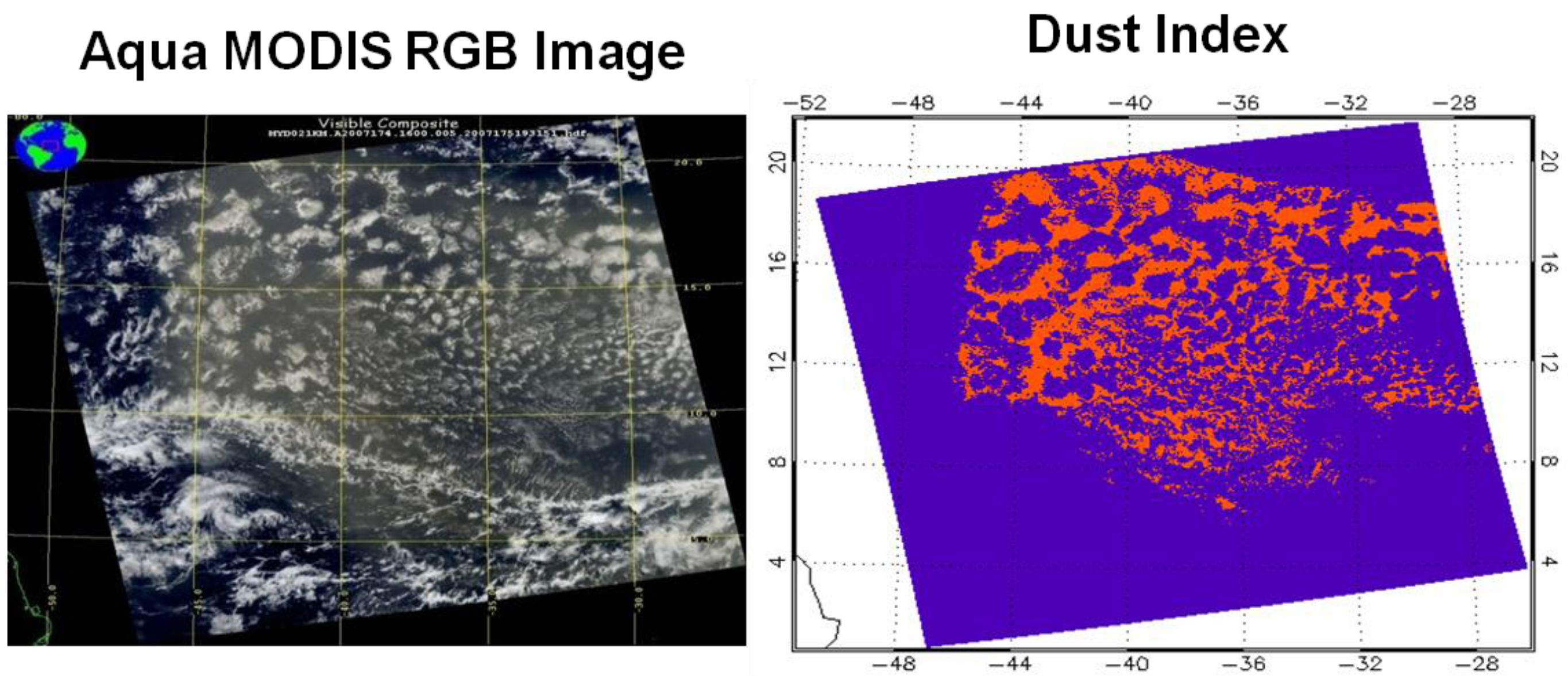
4.3. Smoke over Land
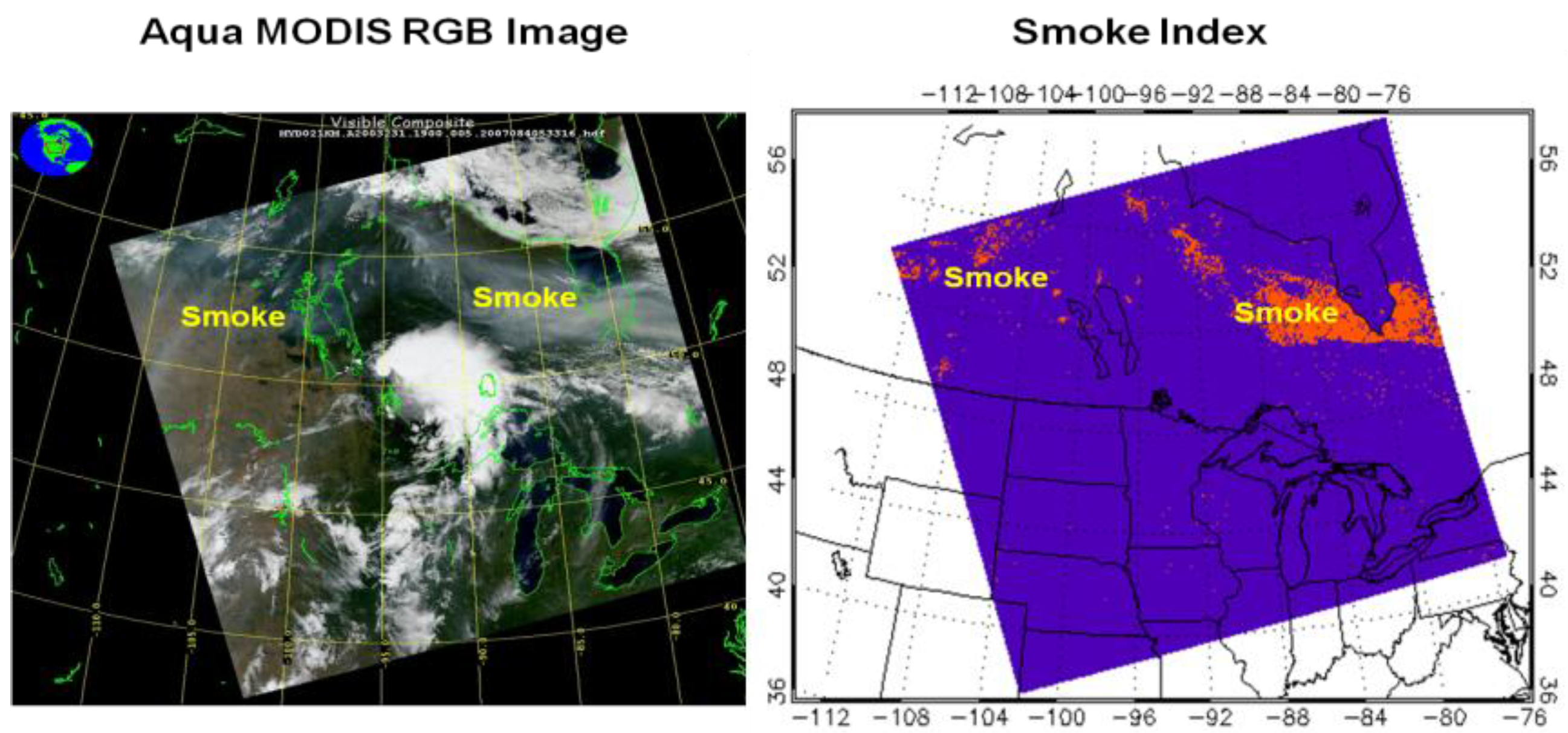
4.4. Smoke over Ocean
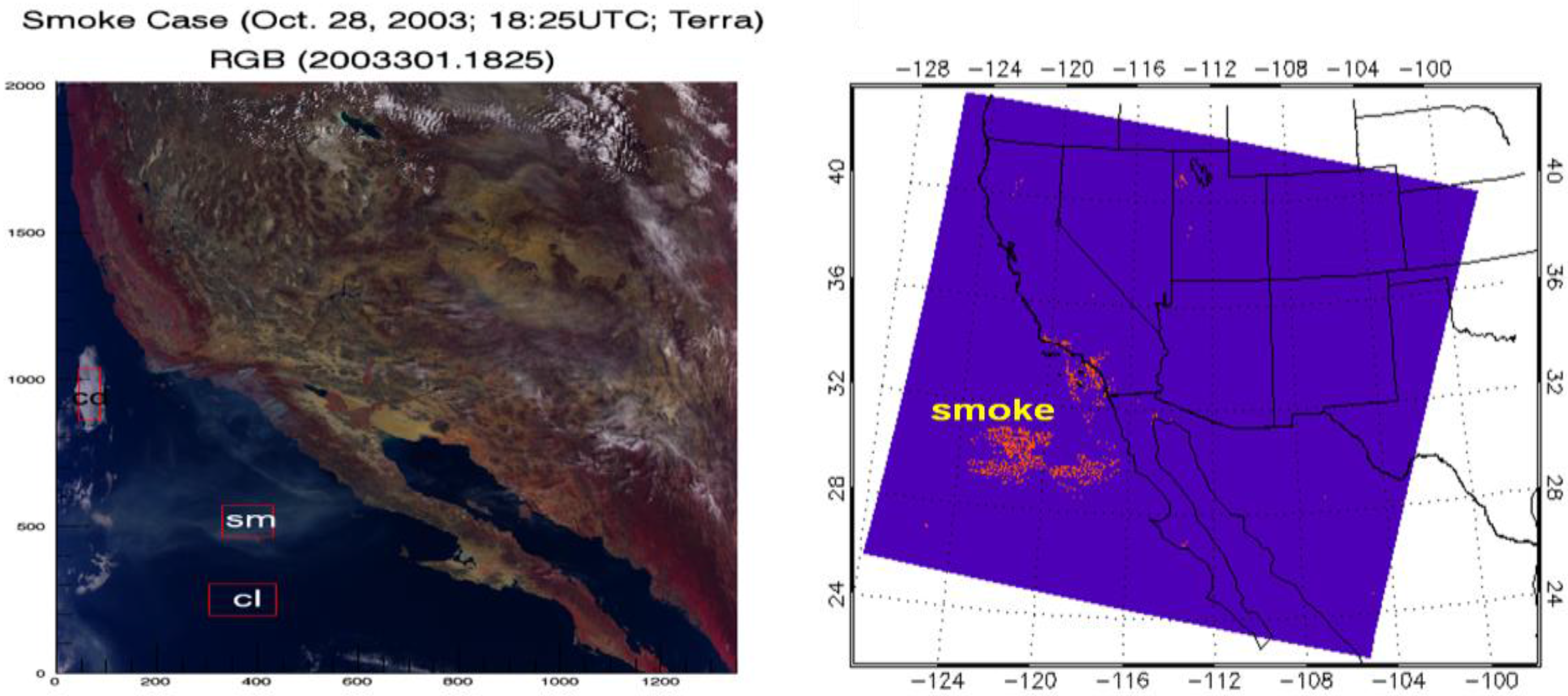
5. Comparison with MODIS Aerosol Retrieval
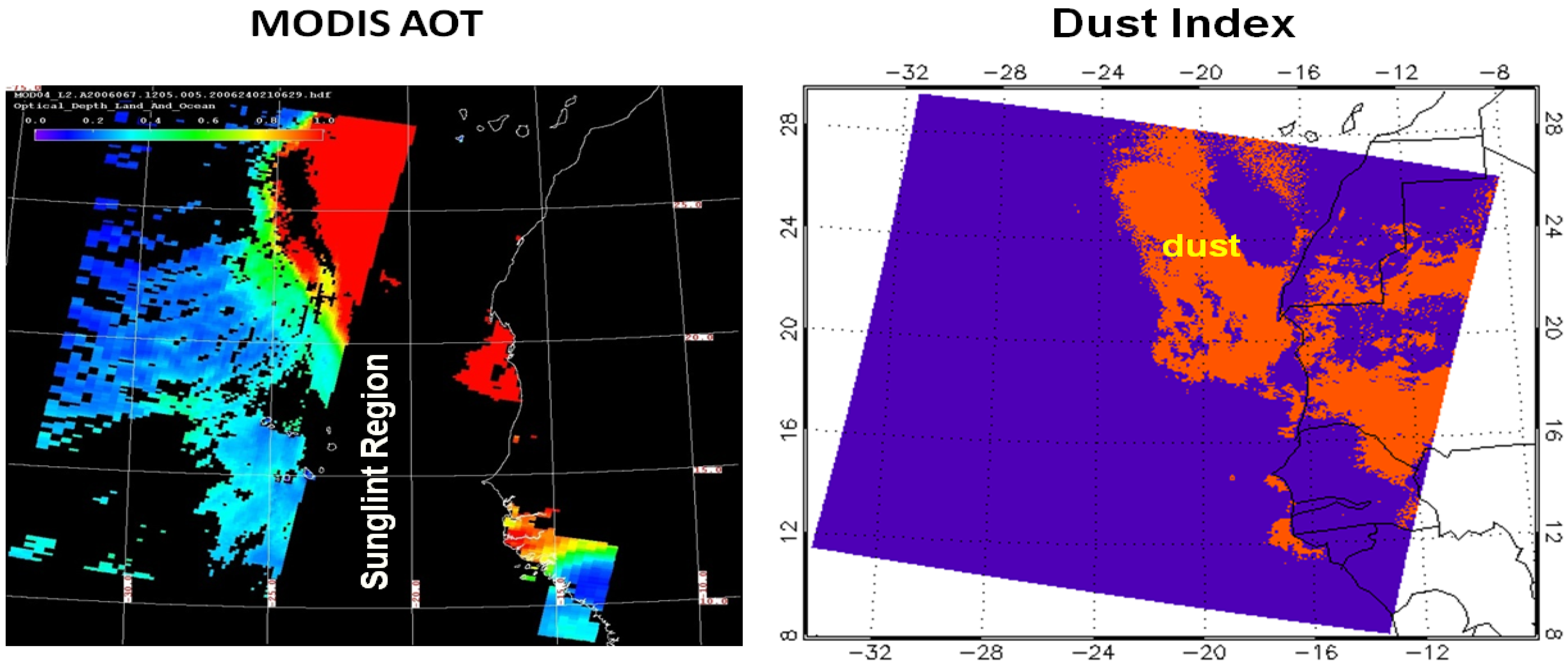
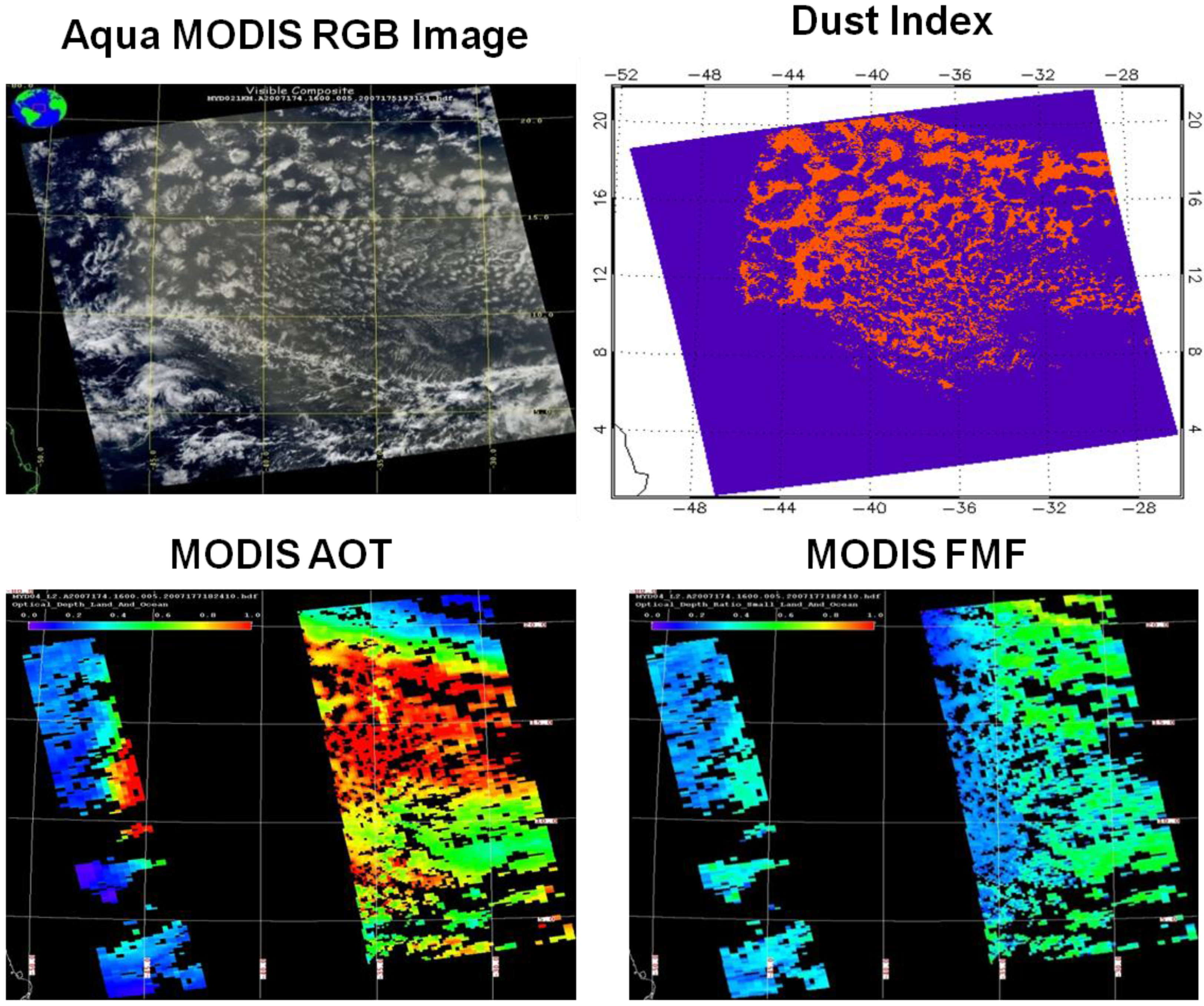
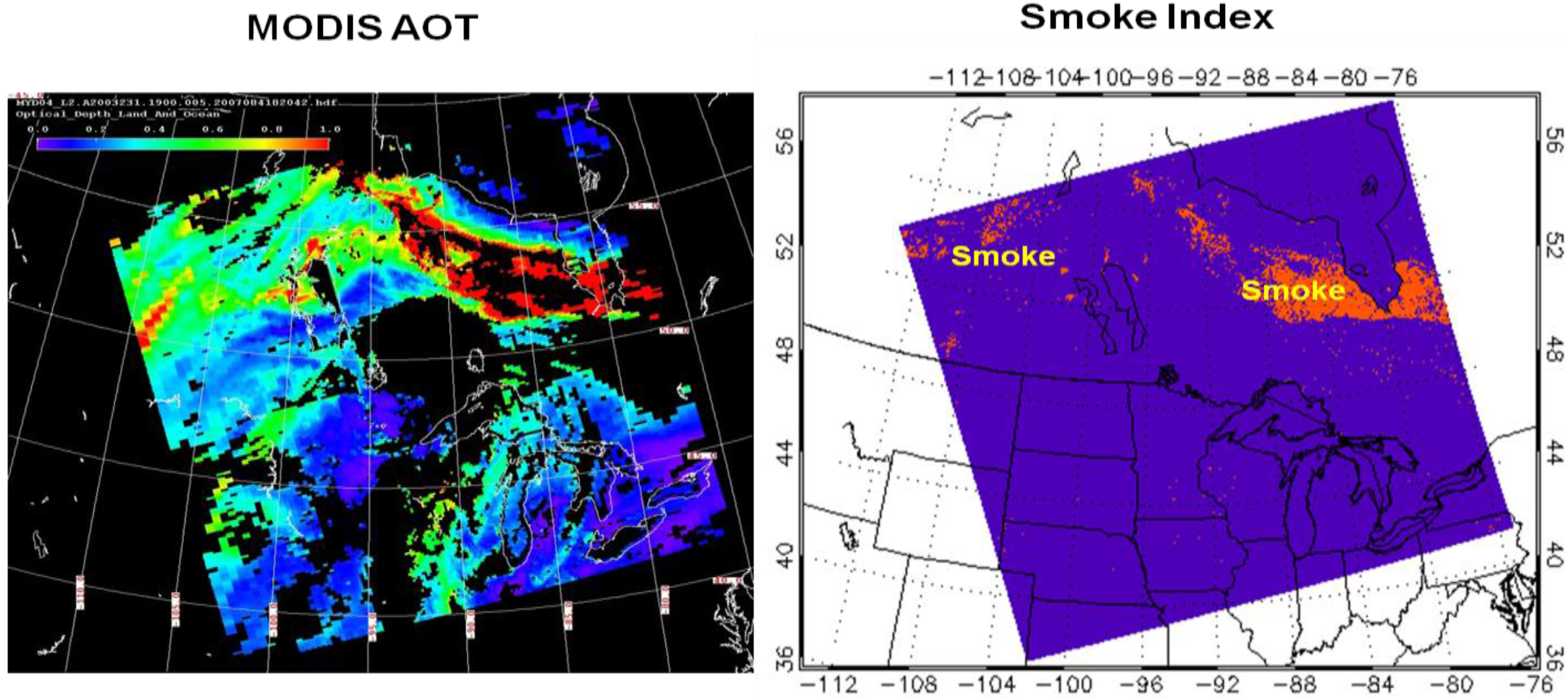
6. Summary and Conclusions
Acknowledgements
References
- IPCC. Climate Change 2007: The Physical Science Basis; Working Group I Contribution to the Fourth Assessment Report of the IPCC; Cambridge University Press: New York, NY, USA, 2007; p. 996. [Google Scholar]
- Tanré, D.; Legrand, M. On the satellite retrieval of Saharan dust optical thickness over land: Two different approaches. J. Geophys. Res. 1991, 96, 5221–5227. [Google Scholar] [CrossRef]
- Ackerman, S.A. Using the radiative temperature difference at 3.7 and 11-μm to track dust outbreaks. Remote Sens. Environ. 1989, 27, 129–133. [Google Scholar] [CrossRef]
- Ackerman, S.A. Remote sensing aerosols using satellite infrared observations. J. Geophys. Res. 1997, 102, 17069–17079. [Google Scholar] [CrossRef]
- Kaufman, Y.J.; Tanré, D.; Remer, L.A.; Vermote, E.F.; Chu, A.; Holben, B.N. Operational remote sensing of tropospheric aerosol over land from EOS moderate resolution imaging spectroradiometer. J. Geophys. Res. 1997, 102, 17051–17067. [Google Scholar] [CrossRef]
- Verge-Depre, G.; Legrand, M.; Moulin, C.; Alias, A.; Francois, P. Improvement of the detection of desert dust over the Sahel using METEOSAT IR imagery. Ann. Geophys. 2006, 24, 2065–2073. [Google Scholar] [CrossRef]
- Christopher, S.A.; Kliche, D.V.; Chou, J.; Welch, R.M. First estimates of the radiative forcing of aerosols generated from biomass burning using satellite data. J. Geophys. Res. 1996, 101, 21265–21273. [Google Scholar] [CrossRef]
- Li, Z.; Khananian, A.; Fraser, R.H.; Cihlar, J. Automatic detection of fire smoke using artifical neural networks and threshold approaches applied to AVHRR imagery. IEEE Trans. Geosci. Remote Sens. 2001, 39, 1859–1870. [Google Scholar]
- Prata, A.J. Observations of volcanic ash clouds in the 10–12 μm window using AVHRR/2 data. Int. J. Remote Sens. 1989, 10, 751–761. [Google Scholar] [CrossRef]
- Barton, I.J.; Prata, A.J.; Watterson, I.G.; Young, S.A. Identification of the Mount Hudson volcanic cloud over SE Australia. Geophys. Res. Lett. 1992, 19, 1211–1214. [Google Scholar] [CrossRef]
- Legrand, M.; Cautenet, G.; Buriez, J.C. Thermal impact of Saharan dust over land. Part II: Application to satellite IR remote sensing. J. Appl. Meteorol. 1992, 31, 181–193. [Google Scholar]
- Legrand, M.; Plana-Fattori, A.; N'Doumé, C. Satellite detection of dust using the IR imagery of Meteosat 1. Infrared difference dust index. J. Geophys. Res. 2001, 106, 18251–18274. [Google Scholar]
- Evan, A.T.; Heidinger, A.K.; Pavolonis, M.J. Development of a new over-water Advanced Very High Resolution Radiometer dust detection algorithm. Int. J. Remote Sens. 2006, 27, 3903–3924. [Google Scholar] [CrossRef]
- Dunion, J.P.; Velden, C.S. The impact of the Saharan air layer on Atlantic tropical cyclone activity. Bull. Amer. Meteorol. Soc. 2004, 85, 353–365. [Google Scholar] [CrossRef]
- Darmenov, A.; Sokolik, I.N. Identifying the regional thermal-IR radiative signature of mineral dust with MODIS. Geophys. Res. Lett. 2005, 32. [Google Scholar] [CrossRef]
- Dubovik, O.; Holben, B.; Eck, T.F.; Smirnov, A.; Kaufman, Y.J.; King, M.D.; Tanré, D.; Slutsker, I. Variability of absorption and optical properties of key aerosol types observed in worldwide locations. J. Atmos. Sci. 2002, 59, 590–608. [Google Scholar] [CrossRef]
- Salomonson, V.V.; Barnes, W.L.; Maymon, P.W.; Montgomery, H.E.; Ostrow, H. MODIS: Advanced facility instrument for studies of the earth as a system. IEEE Trans. Geosci. Remote Sens. 1989, 27, 145–153. [Google Scholar] [CrossRef]
- Remer, L.A.; Kaufman, Y.J.; Tanre, D.; Mattoo, S.; Chu, D.A.; Martins, J.V.; Li, R.R.; Ichoku, C.; Levy, R.C.; Kleidman, R.G.; Eck, T.F.; Vermote, E.; Holben, B.N. The MODIS aerosol algorithm, products, and validation. J. Atmos. Sci. 2005, 62, 947–973. [Google Scholar] [CrossRef]
© 2010 by the authors; licensee MDPI, Basel, Switzerland. This article is an open access article distributed under the terms and conditions of the Creative Commons Attribution license (http://creativecommons.org/licenses/by/3.0/).
Share and Cite
Zhao, T.X.-P.; Ackerman, S.; Guo, W. Dust and Smoke Detection for Multi-Channel Imagers. Remote Sens. 2010, 2, 2347-2368. https://doi.org/10.3390/rs2102347
Zhao TX-P, Ackerman S, Guo W. Dust and Smoke Detection for Multi-Channel Imagers. Remote Sensing. 2010; 2(10):2347-2368. https://doi.org/10.3390/rs2102347
Chicago/Turabian StyleZhao, Tom X.-P., Steve Ackerman, and Wei Guo. 2010. "Dust and Smoke Detection for Multi-Channel Imagers" Remote Sensing 2, no. 10: 2347-2368. https://doi.org/10.3390/rs2102347
APA StyleZhao, T. X.-P., Ackerman, S., & Guo, W. (2010). Dust and Smoke Detection for Multi-Channel Imagers. Remote Sensing, 2(10), 2347-2368. https://doi.org/10.3390/rs2102347




